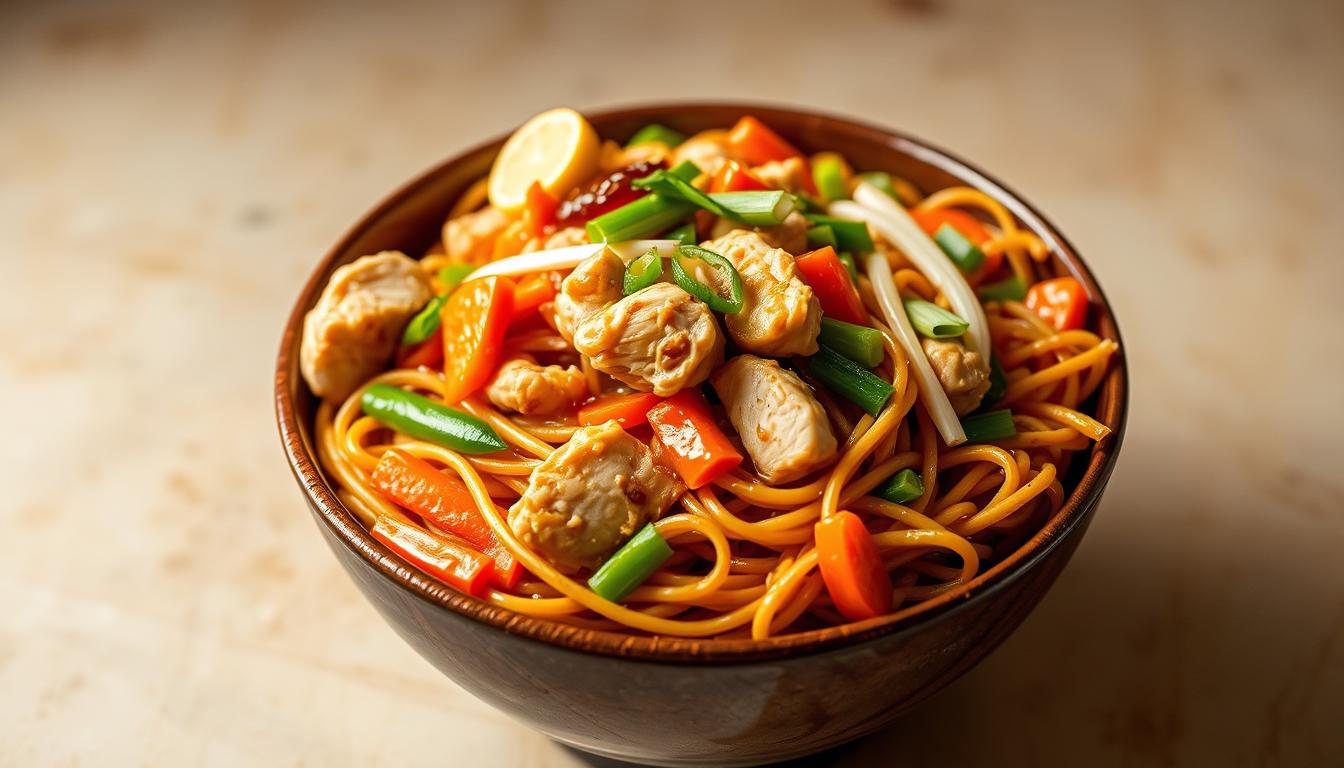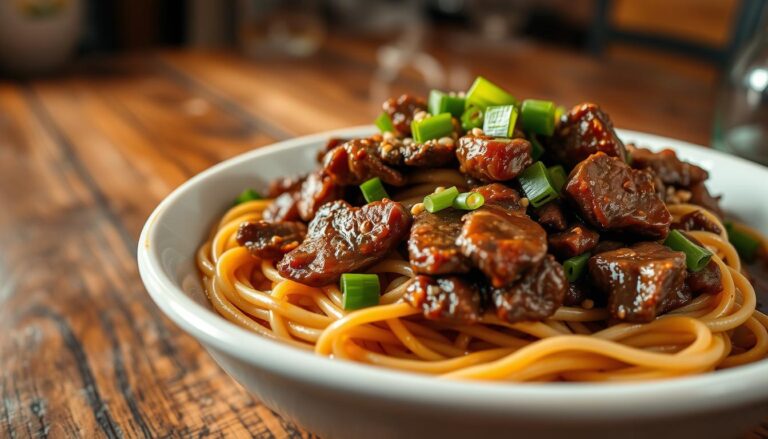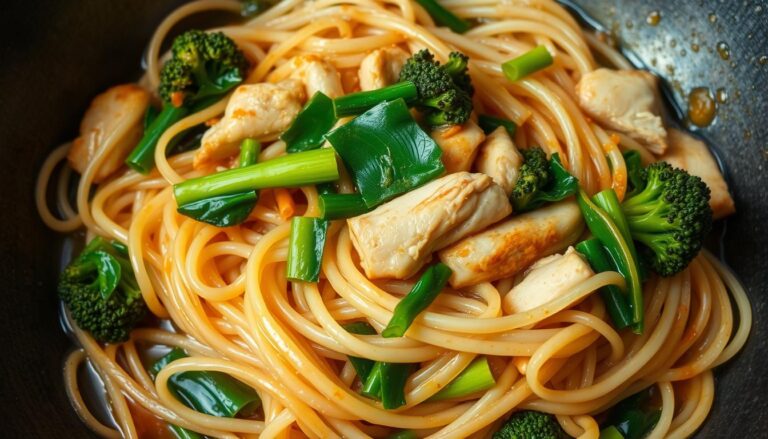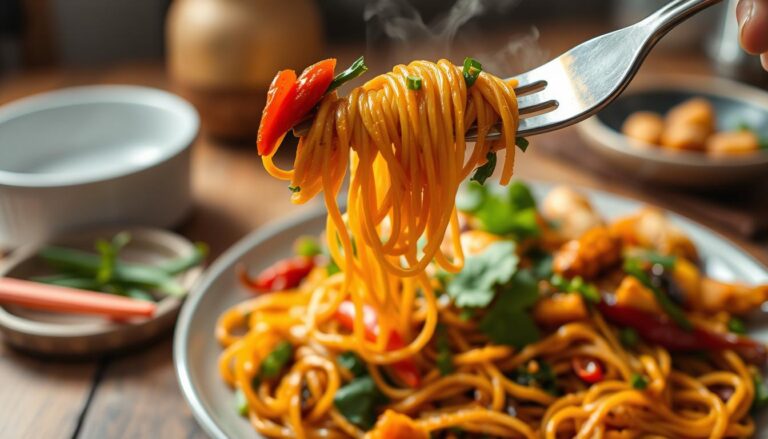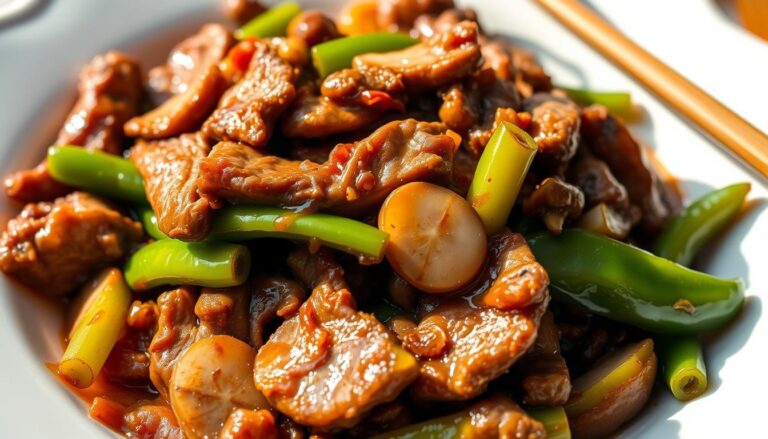Best Chicken Lo Mein Recipe for You | Easy & Authentic
Craving takeout flavors without the hassle? This chicken lo mein recipe brings restaurant-quality noodles to your kitchen in 30 minutes. Perfect for busy weeknights, it combines tender chicken, chewy noodles, and a savory sauce that’s bursting with umami richness.
What makes this dish stand out? The sauce. A blend of soy sauce, garlic, and a touch of brown sugar creates a balanced base, while a splash of sesame oil adds depth. You’ll love how the juicy chicken and crisp veggies cling to every noodle.
Customization is key here. Swap vegetables based on what’s in your fridge, or add a mix of chicken and beef broth for extra richness. Leftovers? They taste even better the next day!
No need for complicated techniques. This recipe focuses on simplicity without sacrificing flavor. Ready to ditch the takeout menu? Let’s get cooking.
Key Takeaways
- Whip up a restaurant-quality meal at home in 30 minutes or less.
- The savory sauce combines soy sauce, garlic, and sesame oil for bold flavor.
- Easily customize with your favorite veggies or leftover proteins.
- Leftovers stay fresh and flavorful for quick next-day meals.
- Uses simple techniques perfect for cooks of all skill levels.
Introduction to Chicken Lo Mein
What if your go-to takeout order could be healthier and faster at home? This noodle dish started as a clever way for Chinese chefs to use leftover ingredients, evolving into a global comfort food favorite. Its magic lies in chewy egg noodles tossed with juicy chicken and whatever veggies you have on hand.
Busy cooks love it because everything cooks in one pan. You’ll spend about 10 minutes chopping, then just 15 more sizzling everything in hot oil. The secret? A quick marinade for the chicken using soy sauce and ginger. This step locks in flavor before the stir fry frenzy begins.
Restaurants might use a blazing-hot wok, but your skillet works too. Toss noodles with crisp veggies like bell peppers or snap peas. Add a splash of water to help the sauce cling better. Suddenly, you’ve got a meal that beats waiting for delivery.
Versatility makes this recipe a keeper. Swap chicken for beef or shrimp. Mix in broccoli or carrots. Every bite stays saucy and satisfying. No wonder home cooks call it their secret weapon against boring dinners.
Essential Ingredients for Authentic Chicken Lo Mein
The secret to restaurant-quality lo mein starts with your shopping list. Fresh components and smart ratios transform basic noodles into a crave-worthy dish. Let’s break down what you’ll need.
Sauce and Marinade Components
Your flavor foundation mixes ¼ cup soy sauce, ½ cup chicken broth, and 1 tbsp brown sugar. Cornstarch thickens the sauce, while minced garlic and ginger add aromatic depth. A splash of sesame oil finishes it with nutty richness.
Marinate thinly sliced chicken in 1 tbsp soy sauce and 1 tsp cornstarch for 15 minutes. This tenderizes the meat and locks in savory notes. Fresh ginger brightens the mix, balancing the salty-sweet profile.
Protein and Vegetables
Opt for boneless chicken thighs – they stay juicy during high-heat stir-frying. Slice them against the grain for maximum tenderness. For veggies, combine crunchy carrots, bell peppers, and cabbage. Mushrooms add earthy undertones.
Customize with snap peas or broccoli. The key? Cut everything uniformly for even cooking. Fresh ingredients ensure crisp textures and vibrant colors. Pair with chewy egg noodles that hold the glossy sauce perfectly.
Step-by-Step Cooking Process for chicken-lo-mein
Mastering this dish comes down to nailing three key stages: marinating your protein, prepping ingredients, and executing the stir-fry dance. Let’s turn your kitchen into a flavor-packed noodle station.
Preparation and Marination
Slice 12 oz of chicken into thin strips. Toss with 1 tbsp soy sauce, 1 tsp cornstarch, and minced garlic-ginger paste. Let sit 15 minutes while you julienne carrots and bell peppers. Boil noodles 1 minute less than package instructions – they’ll finish cooking later.
Cooking and Assembly
Heat 2 tbsp oil in a wok until shimmering. Sear chicken in batches until golden, then set aside. Sauté veggies 2 minutes on high heat. Deglaze with ¼ cup broth, scraping up browned bits.
Add drained noodles and sauce mixture. Toss vigorously for 90 seconds. Return chicken to the pan, stirring until everything glistens. Serve immediately with sesame seeds.
Pro tip: Keep your bowl of prepped items nearby. Stir-frying moves fast – having everything within reach prevents overcooked veggies or rubbery protein.
Tips and Techniques to Elevate Your Chicken Lo Mein Flavor
Transform your home-cooked noodles into a restaurant masterpiece with these chef-approved tricks. Three elements make the difference between good and flavor-packed results: smart marinating, precise heat control, and thoughtful finishing touches.
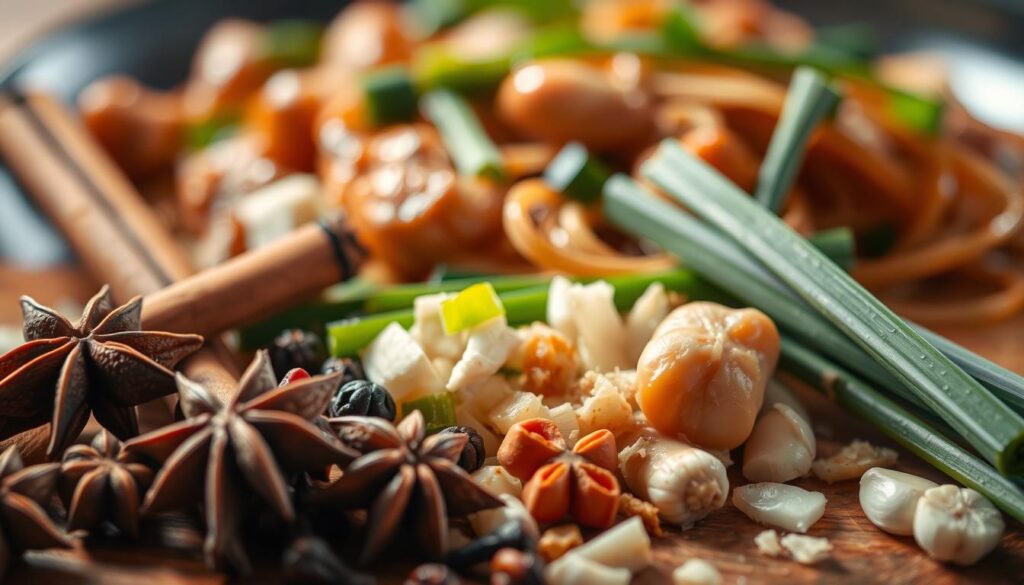
Marinating and Deglazing Secrets
Boost your chicken marinade with 1 tablespoon peanut butter for creamy richness. Always set aside marinated meat for 15 minutes – this tenderizes while you prep other ingredients. When stir-frying, deglaze the pan with 2 tablespoons white wine or broth after cooking the protein. Scrape those golden bits – they hold concentrated savory notes.
Timing and Heat Management
Cook noodles 90 seconds less than package instructions suggest. They’ll finish absorbing the sauce later. Use maximum heat for veggies but work quickly – overcooked peppers turn mushy. Keep your oil shimmering but not smoking to prevent bitter flavors.
Garnishing and Finishing Touches
Top your dish with:
- Crushed peanuts for crunch
- Thinly sliced scallions for freshness
- Crispy fried garlic chips for aroma
Let the finished recipe rest 2 minutes before serving. This allows flavors to meld while keeping textures intact. A final drizzle of soy sauce adds glossy appeal.
Customizing Your Chicken Lo Mein for Different Tastes
Your kitchen becomes a noodle lab with these simple swaps. Whether you’re feeding picky eaters or using up pantry staples, this recipe bends to your cravings without losing its savory core.
Noodle and Vegetable Variations
Egg noodles deliver classic chew, but spaghetti works in a pinch. For gluten-free options, try rice noodles or zucchini ribbons. Fresh varieties cook faster, while dried types offer sturdy texture.
Clear your fridge with these veggie ideas:
- Crunchy snap peas or water chestnuts
- Thinly sliced mushrooms for earthy notes
- Shredded cabbage for quick-cooking bulk
Adjusting the Sauce and Spice Levels
Love sweetness? Add ½ tsp brown sugar to the sauce. Prefer heat? Stir in chili paste or sriracha. For tang, splash rice vinegar into the mix.
Balance flavors by tasting as you go. Too salty? Add a squeeze of honey. Too mild? Boost umami with extra soy sauce. The key is layering ingredients gradually.
Don’t fear experimentation. Swap proteins, try new veggies, or double the garlic. Every tweak makes the recipe uniquely yours – no two batches need taste alike.
Cooking Tools and Methods: From Wok to Skillet
Your cookware choice can make or break your stir-fry game. While both woks and skillets work, each tool brings unique advantages to your noodle dish. Let’s explore how to maximize their potential for crispy chicken and perfectly coated veggies.
Wok vs. Skillet: Heat Heroes
A carbon steel wok excels at high-heat cooking. Its curved shape lets you toss ingredients quickly, preventing soggy noodles. Restaurant chefs love how the hot center sears chicken while the cooler edges gently cook garlic and peppers.
Skillets offer even heat distribution. Their flat surface helps brown proteins uniformly. Use cast iron for better heat retention or stainless steel if you’re still mastering temperature control. Both work when you crank the burner to maximum.
Seasoning Secrets for Non-Stick Success
New wok? Season it like cast iron. Heat 2 tablespoons of oil until smoking, then swirl to coat. Wipe clean and repeat until the surface darkens. This creates a natural non-stick layer that improves with use.
For skillets, rub a thin fat layer (like vegetable oil) after each wash. Avoid soap – it strips seasoning. Well-maintained pans develop a glossy finish that enhances sauce adhesion and prevents sticking.
Always par-cook noodles separately before stir-frying. Drain thoroughly to avoid watery results. Toss them in hot oil for 60 seconds to develop that signature chewy texture. Your dish will taste like it came from a takeout box – without the wait.
Nutritional Information and Serving Suggestions
This chicken lo mein recipe packs flavor without guilt. Each serving delivers 450-500 calories with 35g carbs, 25g protein, and 12g fat. The balanced macros come from lean chicken, fiber-rich veggies, and heart-healthy sesame oil.
Balanced Meal Insights
Pair your noodles with steamed bok choy or edamame for extra greens. “The garlic and pepper in the sauce add antioxidants,” notes a nutritionist. Leftovers? They make perfect lunchbox additions when tossed with fresh carrots or snap peas.
Creative Serving and Storage Tips
Brighten plates with lime wedges or chili flakes. Store cooled portions in airtight containers – 3 days in the fridge, 1 month frozen. Reheat in a skillet with 1 tsp water to revive textures. Avoid microwaving, which can turn noodles gummy.
For next-day meals, stir-fry leftovers with scrambled eggs. The flavor deepens overnight, making this recipe a smart make-ahead option. Want crunch? Top with toasted sesame seeds just before serving.
Conclusion
Your next restaurant-quality meal is just 30 minutes away. This chicken mein recipe proves homemade beats takeout with juicy protein, springy noodles, and that glossy sauce you crave. Remember: marinate in soy-ginger magic, sear with hot oil, and toss everything fast for perfect texture.
Got leftover veggies? Toss them in. Prefer shrimp? Swap it out. The beauty lies in adapting to your fridge’s contents while keeping flavors bold. Those golden stir-fry bits? They’re flavor gold – don’t let them go to waste.
Share your twist online using #HomemadeLoMein. Did doubling the garlic work? Did sesame seeds add crunch? We want to hear it. One pan, endless possibilities – that’s the power of this recipe.
Ready to make nights easier? Grab your skillet. Your new go-to chicken dish awaits, no delivery app required.
FAQ
Can I use other proteins instead of chicken in this recipe?
Yes! Shrimp, beef, or tofu work well. Adjust cooking times based on your protein choice—shrimp cooks faster than chicken, while beef may need extra marination.
What’s the best substitute for soy sauce if I’m avoiding gluten?
Use tamari or coconut aminos for a gluten-free option. Both mimic soy sauce’s umami flavor while keeping the dish celiac-friendly.
How do I prevent noodles from sticking during cooking?
Rinse cooked noodles under cold water and toss with a drizzle of sesame oil. This stops clumping and adds a nutty aroma to your dish.
Can I prep ingredients ahead for faster assembly?
Absolutely. Chop veggies, marinate chicken, and mix the sauce 1–2 days in advance. Store components separately in the fridge for quick stir-frying later.
What vegetables pair best with this dish?
Bell peppers, carrots, mushrooms, and bok choy add crunch and color. Swap in seasonal veggies like snap peas or broccoli for variety.
How do I achieve restaurant-style flavor at home?
Cook on high heat to sear ingredients quickly, and deglaze the pan with a splash of Shaoxing wine or broth to lift caramelized bits for deeper flavor.
Is a wok necessary, or can I use a regular skillet?
A skillet works fine! Ensure it’s large enough to toss ingredients evenly. Carbon steel woks excel for high-heat cooking but aren’t mandatory.
How long does leftover chicken lo mein last in the fridge?
Store in an airtight container for up to 3 days. Reheat in a pan with a splash of water to revive the noodles’ texture.
Can I make this dish less salty?
Reduce sodium by using low-sodium soy sauce or diluting the sauce with a teaspoon of honey or brown sugar to balance flavors.
What’s the ideal noodle type for authentic texture?
Fresh egg noodles or dried lo mein noodles (like Twin Marquis brand) deliver the chewy, springy bite you’d get in takeout dishes.

